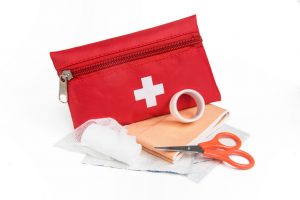Water is the source of great fun and adventure for many. But, it also presents a real risk to your health and safety. Surfboarding, sailboarding, kayaking, and more bring pleasure to millions. Yet, accidents will happen!
NOAA reported only 4 deaths from surfing on U.S. coasts in 2017. But, Scientific American has noticed a correlation; “Surfers and lifeguards blame many of the surf-related injuries—particularly those affecting the spine—on beach replenishment, the process by which new sand is pumped onto beaches to protect the coastline from storms and erosion.”
Some 86% of scuba-diving fatalities happened to divers who were alone. Almost 10% of Americans like paddle sports, but the US Coast Guard reports over 140 fatalities as a result of canoeing and kayaking incidents.
Whatever the cause in whatever sport, thousands of lacerations, contusions, dislocated shoulders, and spinal injuries are reported every year — in addition to the fatalities.
3 pieces of emergency equipment you should have on hand:
If you enjoy scuba-fishing, kiteboarding, windsurfing, kayaking, or more, you need to stay safe while having fun. It you are involved in surf rescue as a lifeguard, a first responder near lake or rapids, or just the parent or buddy of participants, you must keep safety equipment handy.
- Tourniquets constrict and compress limbs to control blood loss in the event of serious lacerations. They apply pressure to muscles, veins, arteries, and tissues to stop or slow bleeding from large bites, deep lacerations, or even amputations.
You usually apply a tourniquet between the injury and heart. The idea is to keep the heart from bleeding out or toxins from reaching the heart. Water will damage an ordinary device, so you should get amphibious tourniquet. You need one that is wearable, rugged, self-locking, compact, and saltwater durable.
- Inflatable vests differ from personal flotation devices and life preservers. They come in different configurations, such as light jackets, vests, or wetsuits. But, they are designed to inflate easily to keep you floating.
Inflatable vests or wetsuits are not bulky or heavy. They do not promise to improve competitive performance, but they are recommended especially for big wave surfing or fast rapids adventures that present the biggest risk to amateurs and trainees.

- First Aid Kit supplies should be accessible to some responsible “water safety buddy.” Boating, surfing, canoeing, or more, you still need access to first aid supplies specific to water injuries.
At a minimum, your kit should include moldable splints, trauma shears, an assortment of sterile bandages and conforming gauze, an irrigation syringe, hand wipes and sanitary gloves, and basic medications, such as iodine, antibiotic ointment, and over-the-counter painkillers. If you are familiar with specific risks in the area or the water, you should add precautions.
Staying safe while having fun!
You must designate a go-to contact within easy reach who can watch your water adventures. Someone needs to manage any crisis that might arise, especially when you are far from protected beaches or locations.
You must put together your use safety equipment, prepare an emergency kit, and discuss safety procedures with a designated buddy. It should include a safe word or sign that tells the observer when you need help. You and your “lifeguard” must know how to reach local emergency services.
And, your buddy must have a charged smartphone able to reach local first responders. Most fatalities and serious injuries happen when and where there is no connection with the people who know how to handle and manage emergencies. So, you must prepare!
Recent Posts
- Castor Oil For Better Hair Growth: Is It Myth Or Fact?
- Exploring the Differences Between Sermorelin, Ipamorelin, Ibutamoren, GHRP2, and GHRP6: Understanding Their Role in Human Growth Hormone Regulation
- Unraveling the Mystery: Understanding the Causes and Prognosis of Ventricular Tachycardia Without Apparent Heart Disease
- Understanding Grandparents’ Rights in Oklahoma: Navigating Visitation and Legal Protections
- 10 Reasons to Consider Hypnotherapy for Your Health
